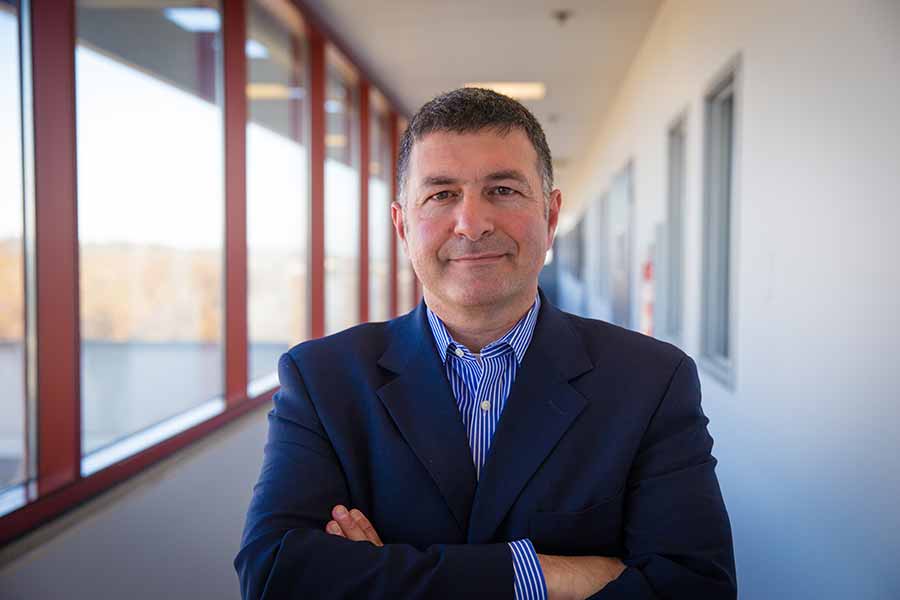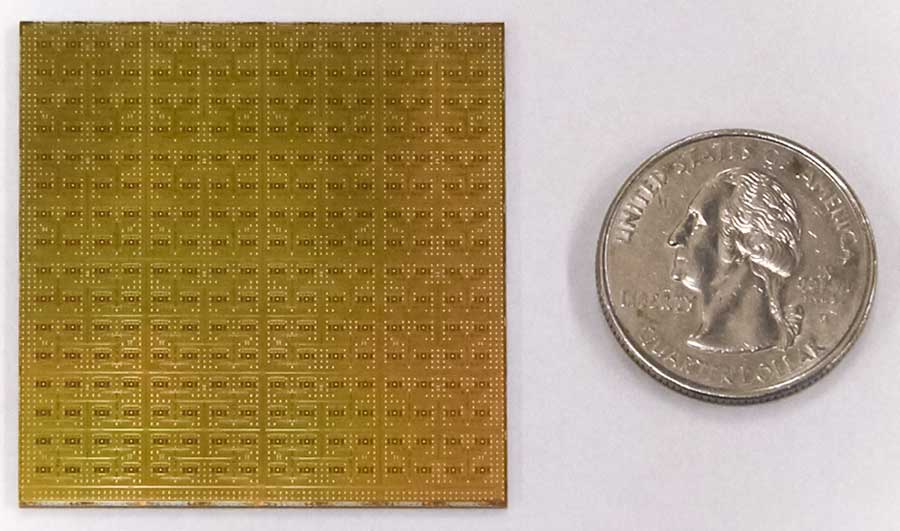
By:
- Daniel Kane
Published Date
By:
- Daniel Kane
Share This:
Electrical Engineering Professor Gabriel Rebeiz Elected to National Academy of Engineering
Research will help to realize more reliable airplane Internet, faster smartphone connections and more
In order to get Internet service to airline passengers five or six miles up in the air, airlines mount antenna systems to the tops of their planes. The systems are bulky and generate drag which reduces fuel efficiency. In the next five years or so, electronically steered antennas that are lighter, generate less drag and are more reliable will replace today’s mechanically driven airplane internet systems.

Electrical Engineering Professor Gabriel Rebeiz
Advances in the development of these types of arrays of electronically steered antennas, known as phased arrays, are part of what earned UC San Diego electrical engineering professor Gabriel Rebeiz a spot in the National Academy of Engineering (NAE), one of the highest professional honors an engineer can receive.
Rebeiz is being recognized by the NAE for contributions to radio frequency microelectromechanical systems (RF MEMS) and phased array technologies.
“With phased arrays, we are migrating from mechanical movement to electronic scanning,” explained Rebeiz, who holds the Wireless Communications Industry Chair at the UC San Diego Jacobs School of Engineering.
Automotive radar systems
Arrays of electronically steered antennas are also being incorporated into next-generation automotive radar systems designed to keep drivers, and the pedestrians around them they may not see, safe. These types of systems could also be incorporated into driverless cars of the future.
Through a hardware development project led by Toyota Technical Center, Ann Arbor, Rebeiz and his research team at UC San Diego worked on the new automotive radar system, which captures high-resolution images of an approximately 100-meter area surrounding a moving car.
Rebeiz described the experimental phased array radar system as somewhat like a telescope or a “zoom” lens. The array of antennas moves left and right in a regular pattern across the area surrounding the car, capturing high-resolution images of what is happening with less than a micro-second delay.

Wafer-Scale Silicon 256-element 60 GHz 5G Phased Array Transmitter for Gbps Communications. Photo by Gabriel Rebeiz/UC San Diego
The information their system generated is far more detailed than what is available from the first-generation automotive radar systems that are installed in many of today’s cars and assist with things like changing lanes and maintaining a safe distance from other cars. Rebeiz also led a team that worked on aspects of the hardware for these first-generation radar systems, though he has been more deeply involved in this second-generation project.
The hardware development project included a large number of graduate students and postdoctoral researchers from Rebeiz’s electrical engineering lab. The work won a 2014 R&D 100 Award from R&D Magazine for its automotive phased array radar.
Phenomenal students
Rebeiz has mentored and supervised approximately 100 graduate students and postdoctoral researchers over the years, first at the University of Michigan and at UC San Diego since 2005.
“I am most proud of my students,” said Rebeiz. “My students have been phenomenally successful. They are the light of my eyes.”
His former students are working all across academia and industry. Steve Mollenkopf, for example, was one of Rebeiz’s students from the University of Michigan. He is the Chief Executive Officer of Qualcomm Inc.
“I applaud Gabriel for his dedication as a researcher, educator and mentor,” said Albert P. Pisano, Dean of the UC San Diego Jacobs School of Engineering. “He is training tomorrow’s technology leaders while at the same time pursuing cutting edge research and ensuring that these advances are transferred to society.”
5G: Fifth-generation wireless
One of the most high profile places phased array research advances will probably enter society is through fifth-generation (5G) mobile wireless broadband networks. Phased arrays will likely be integrated into mobile devices as well as cellular base stations. By the early 2020s, 5G systems are expected to provide high data rates to mobile users, up to 1 gigabit per second, thanks in part to phased array antenna systems which will steer, focus and extend the reach of high bandwidth wireless signals in the millimeter wave frequency.
“5G standards will be based on phased arrays, both for base stations and for mobile devices including phones, tablets and laptops,” said Rebeiz. “We are now building 28 Gigahertz phased arrays for 5G and will have working systems by the end of the year.”
Rebeiz is part of the Center for Wireless Communications (CWC) at UC San Diego, which will hold a 5G Mobile and Connected Health Workshop on May 11 followed by the CWC 5G Forum on May 12 and13. Read a 2015 5G Forum wrap-up story here.
Fast internet at home
High bandwidth wireless communications through point-to-point wireless channels is another commercial application for the phased array technologies Rebeiz has influenced.
“Over the next five years, wireless communications systems will have enormously more bandwidth and information carrying capability. This will be achieved partially by making use of higher frequency regions of the RF spectrum, up to millimeter waves,” said UC San Diego electrical engineering professor Peter Asbeck. “In order to make this work, engineers will use directional antennas that are made with phased array technologies. This involves many miniature antennas that are phased differently to send beams in particular directions. In order to drive those systems, you need lots of electronics, and Gabriel is the world leader in putting lots and lots of the millimeter wave electronics in silicon circuits," explained Asbeck, the Skyworks Professor in High Performance Communications Devices and Circuits at UC San Diego.
In late 2015, Rebeiz and his UC San Diego research team took part of an academic-industry collaboration with Keysight Technologies that used phased arrays to demonstrate the first 60 GHz 5G wireless communication link. The researchers set up a 2 gigabit per second wireless link that spanned more than 100 meters. For comparison, a standard Wi-Fi connection today might carry just 30 to 50 megabits of data per second.
These high bandwidth wireless links are poised to eventually replace the “last mile” fibers that currently connect individual residences to much faster Internet pipes. The neighborhood boxes that serve as the fiber-optic “exit and entrance ramps” to these faster data pipes will remain, but the connection between the box to individual residences will be wireless and most probably, at 60 GHz. Poles with arrays of electronically steered directional antenna systems will provide line-of-site connections to individual residences or multi-unit buildings.
“Trees within the path of the wireless signal are okay, though you do get some amount of attenuation,” Rebeiz explained.
The neighborhood streets in Rebeiz’s neighborhood are currently being torn up to replace existing last-mile fibers with newer physical connections.
With a smile, Rebeiz noted that in addition to much faster data rates, the phased-array wireless last-mile systems of the future will have another benefit.
“They will not need to dig up the streets anymore.”
Share This:
Stay in the Know
Keep up with all the latest from UC San Diego. Subscribe to the newsletter today.


